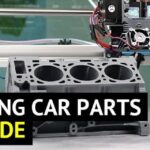For DIY car enthusiasts and those looking to restore or customize their vehicle’s interior, the allure of 3D printing technology is strong. The idea of creating custom Car Interior Replacement Parts at home seems like a revolutionary step forward. However, when it comes to the longevity and durability of components within your car’s cabin, especially those exposed to daily wear and tear, it’s crucial to understand the limitations of 3D printing, particularly Fused Deposition Modeling (FDM), and materials like PLA, ABS, and even alternatives like PETG.
While 3D printers, more accurately termed rapid prototypers, excel at creating prototypes, they aren’t always the best solution for producing durable, long-lasting car interior replacement parts. The fundamental issue lies in the materials commonly used in FDM 3D printing. Plastics like PLA, while easy to work with and popular for prototyping, and even ABS, which the industry is moving away from due to health concerns, simply don’t match the performance of the stock plastics used in vehicle interiors. Recent studies have also raised concerns about PLA’s carcinogenic properties in extrusion-based manufacturing, further emphasizing the need for caution. PETG, often touted as a safer alternative, shares similar limitations in this context.
One critical aspect of car interior parts, such as handle surrounds or trim pieces, is their reliance on clips for secure attachment. 3D printed parts, especially those made from thermoplastics, can struggle in this area. Unless the fit is absolutely perfect, any stress on these clip ledges, combined with the heat often experienced inside a car, can lead to deformation over time. Thermoplastics are susceptible to warping and bending under heat, which is a significant concern for parts within a car’s interior, especially on a hot day.
Furthermore, while automotive plastics are designed to withstand UV exposure, 3D printed plastics tend to degrade and become brittle much faster when exposed to sunlight. This is a major drawback for car interior replacement parts that are constantly exposed to sunlight streaming through windows. The fading and brittleness not only detract from the aesthetic appeal but also compromise the structural integrity of the part.
Despite these limitations, experimentation and learning are valuable. If you have access to a 3D printer and are keen to experiment with creating car interior replacement parts, it’s a worthwhile learning experience to understand the technology’s boundaries. However, for producing truly reliable and durable components, especially those requiring precise fits and long-term resilience, alternative methods often prove superior.
For instance, CNC milling offers a far more robust solution. With CNC milling, you can create car interior replacement parts from a wide variety of materials, achieving a level of precision and material strength that FDM 3D printing struggles to match. At the very least, CNC milling can be used to create a negative mold for injection molding or casting, processes that can yield parts virtually indistinguishable from factory-original components. These methods, while perhaps seeming a bit “old-school” compared to 3D printing, provide a pathway to creating car interior replacement parts that are truly built to last and withstand the harsh conditions within a vehicle.
Ultimately, while 3D printing offers exciting possibilities for prototyping and customization, for critical car interior replacement parts that demand durability, heat resistance, and UV stability, traditional manufacturing methods like CNC milling and injection molding remain the more reliable and effective choices. Understanding these limitations is key to making informed decisions when seeking to repair or upgrade your car’s interior.
